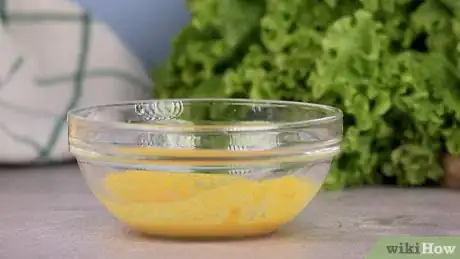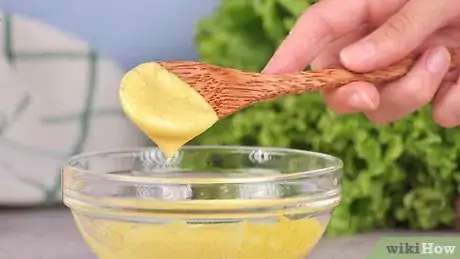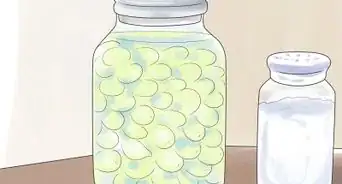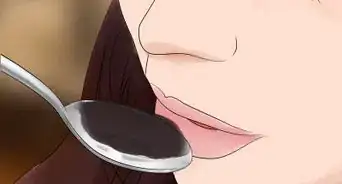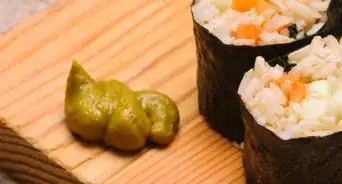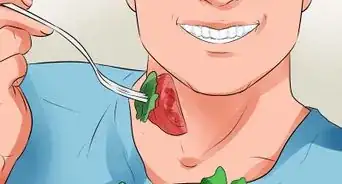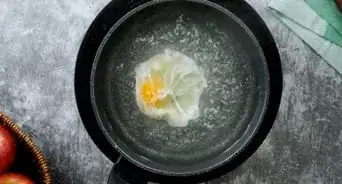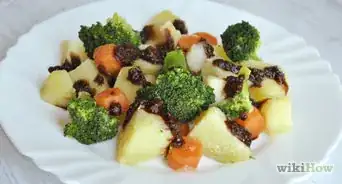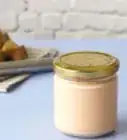This article was co-authored by wikiHow staff writer, Hannah Madden. Hannah Madden is a writer, editor, and artist currently living in Portland, Oregon. In 2018, she graduated from Portland State University with a B.S. in Environmental Studies. Hannah enjoys writing articles about conservation, sustainability, and eco-friendly products. When she isn’t writing, you can find Hannah working on hand embroidery projects and listening to music.
There are 17 references cited in this article, which can be found at the bottom of the page.
The wikiHow Culinary Team also followed the article's instructions and verified that they work.
This article has been viewed 588,387 times.
Learn more...
Dijon mustard is a great addition to sandwiches, subs, and wraps. It’s healthier than most other condiments, and it makes a nice, creamy addition to recipes that you may already make at home. While it can be purchased already made from the store, the commercial mustard is no substitute for mixing up your own mixture right in your own kitchen. You can pick from a few different recipes to try whenever you’re craving a spicy, sweet condiment to spread on your lunch or dinner.
Ingredients
- 1 cup (85 g) of chopped onion
- 2 minced cloves of garlic
- 1 c (240 mL) of water
- 2⁄3 c (160 mL) of white vinegar
- 1.5 cups (350 mL) of white wine
- 1 cup (128 g) of whole mustard seeds
- 1/4 cup (32 g) of dried mustard
- 1 tbsp (17 g) of garlic powder
- 1 tsp (4 g) of salt
- 1/4 cup (115 g) of brown mustard seeds
- 1/4 cup (115 g) of yellow mustard seeds
- 1⁄2 cup (120 mL) of dry white wine
- 1⁄2 cup (120 mL) of white vinegar
- 1/2 tsp (2.5 g) of kosher salt
- 1 tsp (5 g) of light brown sugar
- 1 tbsp (14 g) of dry mustard
- 1 tsp (4.9 mL) of water
- 1 tsp (4.9 mL) of white wine vinegar
- 1 tbsp (14 g) of mayonnaise
- a small pinch of granulated sugar
Steps
Classic Dijon Mustard
-
1In a small pot, heat the garlic, wine, vinegar, water, and onion to a boil. Add 1 cup (85 g) of chopped onion, 2 minced cloves of garlic, 1 c (240 mL) of water, 2⁄3 c (160 mL) of white vinegar, and 1.5 cups (350 mL) of white wine to a small pot. Turn the heat on high and wait until you see large bubbles rising to the top of the mixture.[1]
- You can use any kind of white wine that you have handy.
- White wine is what separates Dijon mustard from other types of mustard.
-
2Reduce the heat and simmer the mixture for 15 minutes. Turn the stovetop down to medium low and allow the flavors to combine for about 10 to 15 minutes. You can leave the pot uncovered for now to let the steam escape as it cooks.[2]
- You don’t need to stir the mixture; because there’s a lot of liquid, there isn’t much chance of it burning.
- Simmering the mixture will also help burn the alcohol out of the white wine so the taste isn’t quite as strong.
Advertisement -
3Turn off the heat and cool the mixture to room temperature. Quickly turn off your stove top and move the pot to a burner that’s off. Let the pot sit for about 10 minutes, or until it’s room temperature, before you move on.[3]
-
4Strain the liquid into a large bowl. Hold a fine mesh strainer over a large bowl and carefully pour your liquid through it. Throw away the chunks of onion and garlic, but keep the liquid in the bowl.[4]
- It can be a little tough to hold the strainer and pour at the same time, so don’t be afraid to ask a friend or family member for help!
-
5Add the mustard seeds, dry mustard, garlic powder, and salt to the liquid. Pour 1 cup (128 g) of whole mustard seeds, 1/4 cup (32 g) of dried mustard, 1 tbsp (17 g) of garlic powder, and 1 tsp (4 g) of salt to the liquid. Stir the dry ingredients into the liquid with a wooden spoon until they’re fully incorporated.[5]
- You’ll blend the mustard seeds later, so don’t worry about it being too chunky.
-
6Cover the bowl and let it sit for 24 to 48 hours. Grab a sheet of plastic wrap and use it to cover your bowl of mustard, making sure that it’s airtight. Leave the bowl on the counter at room temperature to let the mustard solidify for 1 to 2 days.[6]
- Keep the bowl out of direct sunlight so it doesn't get too hot. Hot mustard breeds bacteria, and that’s a big no-no for a delicious condiment like this.
-
7Pulse the mustard in a blender. Pour your mustard mixture into a blender and pulse the blender a few times. The consistency of your mustard is up to you, so you can stop once all of the mustard seeds are blended, or you can keep going to make your mustard smoother and creamier.[7]
- You can also use a handheld blender and blend your mustard in the bowl.
- Creamy mustard is better for adding to recipes, while chunkier mustard can add a little bit of texture to a sandwich or a wrap.
-
8Heat the mustard in a saucepan and add water. Pour the mustard into a saucepan and turn the heat up to high. Slowly add in about 1⁄2 c (120 mL) of water to smooth out your mustard and thin it out. Use a whisk to combine the water and the mustard mixture.[8]
- Add more water if you’d like your mustard to be runnier, and add less water if you prefer your mustard a little thicker.
-
9Simmer the mustard for about 10 minutes. Turn the heat down to medium low and keep the pan uncovered, letting the mustard simmer for 10 minutes. Stir the mustard occasionally to keep the bottom from burning as it absorbs the water.[9]
-
10Store the mustard in airtight glass jars. Carefully spoon your mustard into clean, sterile jars, filling them about 3/4 of the way up. Run a butter knife along the edge of the jars to remove any air bubbles before you seal them with an airtight lid.[10]
- You can use multiple small jars or one large jar to store your mustard.
- Look for glass canning jars at your local grocery store for a cute, easy storage solution.
-
11Refrigerate the mustard for about 1 week. The flavors of the mustard will continue to blend in the jar. Try to keep your mustard in the fridge for at least a week so your mustard is the most flavorful before you try it.[11]
- Consider writing the date that you made the mustard on the jars so you know when it’s time to eat it.
Whole Grain Dijon Mustard
-
1Put the mustard seeds, wine, and vinegar into a small bowl. Add 1/4 cup (115 g) of brown mustard seeds, 1/4 cup (115 g) of yellow mustard seeds, 1⁄2 cup (120 mL) of dry white wine, and 1⁄2 cup (120 mL) of white vinegar to a small bowl. You don’t need to worry about blending up the mustard seeds just yet—plus, soaking them will make them softer.[12]
- Whole grain Dijon mustard isn’t quite as smooth and creamy as classic Dijon mustard, since you won’t be blending the mustard seeds all the way. It’s slightly more spicy and flavorful than classic Dijon.
-
2Cover the bowl with plastic wrap and let it sit for 2 days. Grab a sheet of plastic wrap and cover your bowl tightly, making sure no air can escape. Leave the bowl covered on the counter for 2 days to let the flavors combine.[13]
- Keep the bowl out of the direct sunlight so that it doesn’t get too hot.
-
3Transfer the mixture to a blender and add in salt and sugar. Take the plastic wrap off the bowl and pour your mixture into a blender. Add in 1/2 tsp (2.5 g) of kosher salt and 1 tsp (5 g) of light brown sugar.[14]
- You don’t have to add brown sugar to your mustard, but it will make it slightly sweeter and more flavorful.
- You can also add 1 tsp (5 g) of honey instead of brown sugar for a honey mustard flavor.
-
4Blend the mixture until it’s thick and creamy. Pulse your blender 3 to 4 times until the mixture is smooth, but the mustard seeds aren’t completely broken up. Remember that whole grain mustard is supposed to be chunky, not smooth, so don’t overblend it![15]
- If you don’t have a blender, use a food processor instead.
-
5Pour the mixture into an airtight container. Using a rubber spatula, spoon the mixture into a plastic or glass container with a lid. Seal the lid and write the date on the outside so you know when it’s time to eat your mustard.[16]
- Canning jars are a great way to store your mustard; plus, you can decorate them with stickers, labels, or ribbons.
-
6Refrigerate the mustard for 2 days before you eat it. Just like classic Dijon mustard, the flavors of the whole grain mustard need to combine for a few days after you make it. Keep your mustard in the fridge for at least 2 days before serving it on hot dogs, sandwiches, or wraps.[17]
- For a stronger flavor, let your mustard sit for 1 week.
Making a Dijon Substitute
-
1Combine dry mustard, water, and white wine vinegar in a bowl. In a small bowl, put 1 tbsp (14 g) of dry mustard, 1 tsp (4.9 mL) of water, and 1 tsp (4.9 mL) of white wine vinegar. Use a whisk or a spoon to mix them together until the dry mustard is dissolved.[18]
- If you don’t have white wine vinegar, you can use 1⁄2 tsp (2.5 mL) of white wine and 1⁄2 tsp (2.5 mL) of white vinegar instead.
-
2Add in mayonnaise and granulated sugar. Drop in 1 tbsp (14 g) of mayonnaise and a small pinch of granulated sugar. The mayonnaise will smooth the mixture out, while the sugar will give the hint of sweetness that Dijon is known for.[19]
- You can use honey instead of sugar, if you’re so inclined.
-
3Mix the ingredients with a spoon until they’re creamy. Using a whisk or a spoon, mix your ingredients together for about 1 minute until they are smooth and creamy. The resulting mixture should be a bright yellow color that tastes a little like dijon mustard and a little like yellow mustard.[20]
- Classic Dijon mustard includes actual mustard seeds, which is the main thing missing from this substitution.
- If your mustard isn’t the right color, add in 1/4 tsp (1.5 g) of turmeric powder for a classic brown/yellow coloring.
-
4Use this Dijon-like mustard for a quick substitution. You can use this Dijon-like mustard in recipes that call for it if you don’t have the time to make it yourself. Or, if you’re really craving a sandwich with some Dijon mustard but you want to eat it right away, you can spoon some of this on for a more subtle and sweet mustard flavor.[21]
- One of the only drawbacks of Dijon mustard is that it takes a long time to make, so this substitution comes in handy when you’re in a pinch.
Using Dijon Mustard
-
1Spread Dijon mustard on hot dogs and sandwiches for an easy condiment. Whether it’s the classic or the whole grain mustard, Dijon adds a spicy tang to any hot dog, bratwurst, or sandwich. Use a tablespoon or two to add a hearty flavor to your meal, and give your deli sandwich a little spice.[22]
- Dijon mustard goes well with chicken sandwiches, turkey sandwiches, and sausages.
- Try putting Dijon mustard on a vegan sandwich made with lettuce, spinach, tomatoes, and thinly sliced eggplant.
-
2Make deviled eggs with Dijon mustard for a spicy, tangy flavor. Peel and slice 12 hard-boiled eggs, then scoop out the yolks with a spoon. Mash up the yolks and add 2 tbsp (28 g) of Dijon mustard, 1/3 cup (43 g) of mayonnaise, and 1⁄4 teaspoon (1.2 mL) of Tabasco sauce, then put the filling back into the egg whites.[23]
- You can also add salt, pepper, and paprika to taste to make the filling more flavorful.
- Adding Dijon mustard to deviled eggs will make them taste spicier and less acidic than eggs with yellow mustard.
-
3Mix Dijon mustard with mayonnaise for a salad dressing. Combine 1 tsp (4 g) of Dijon mustard with 1.5 tbsp (22.5 g) of mayonnaise in a small bowl. Add salt and pepper to taste, then pour the dressing onto a green leaf salad for a spicy, tangy taste. Add some croutons for an extra crunch.[24]
- Try adding in 1⁄2 teaspoon (2.5 mL) of white wine for an extra kick.
-
4Whip up a few ham and cheese sliders as an easy appetizer. Mix together Dijon mustard, Worcestershire sauce, poppy seeds, and a chopped onion in a bowl. Layer ham, Swiss cheese, and the mustard mix onto bread rolls, then put them in the oven for about 20 minutes to melt the cheese.[25]
- Serve the sliders while they’re hot for your guests to enjoy!
Community Q&A
Did you know you can get answers researched by wikiHow Staff?
Unlock staff-researched answers by supporting wikiHow
-
QuestionWhat can I use if I don’t have Dijon mustard?
 wikiHow Staff EditorThis answer was written by one of our trained team of researchers who validated it for accuracy and comprehensiveness.
wikiHow Staff EditorThis answer was written by one of our trained team of researchers who validated it for accuracy and comprehensiveness.
Staff Answer wikiHow Staff EditorStaff Answer
wikiHow Staff EditorStaff Answer -
QuestionWhat does à la Dijonnaise mean?
 wikiHow Staff EditorThis answer was written by one of our trained team of researchers who validated it for accuracy and comprehensiveness.
wikiHow Staff EditorThis answer was written by one of our trained team of researchers who validated it for accuracy and comprehensiveness.
Staff Answer wikiHow Staff EditorStaff Answer
wikiHow Staff EditorStaff Answer -
QuestionWhat does Dijon mustard go well with?
 wikiHow Staff EditorThis answer was written by one of our trained team of researchers who validated it for accuracy and comprehensiveness.
wikiHow Staff EditorThis answer was written by one of our trained team of researchers who validated it for accuracy and comprehensiveness.
Staff Answer wikiHow Staff EditorStaff Answer
wikiHow Staff EditorStaff Answer
Things You'll Need
Classic Dijon Mustard
- 2 small saucepans/cooking pots
- Wooden spoon
- Cutting board and knife
- Glass jars with lids
Whole Grain Dijon Mustard
- Blender
- Airtight container
- Bowl
- Plastic wrap
- Airtight container
Making a Dijon Substitute
- Bowl
- Spoon
References
- ↑ https://www.allrecipes.com/recipe/240790/chef-johns-dijon-mustard/
- ↑ https://www.allrecipes.com/recipe/240790/chef-johns-dijon-mustard/
- ↑ https://www.youtube.com/watch?v=5DgG62sln2Y&feature=youtu.be&t=66
- ↑ https://www.youtube.com/watch?v=5DgG62sln2Y&feature=youtu.be&t=74
- ↑ https://www.youtube.com/watch?v=5DgG62sln2Y&feature=youtu.be&t=97
- ↑ https://www.allrecipes.com/recipe/240790/chef-johns-dijon-mustard/
- ↑ https://www.allrecipes.com/recipe/240790/chef-johns-dijon-mustard/
- ↑ https://www.youtube.com/watch?v=5DgG62sln2Y&feature=youtu.be&t=204
- ↑ https://www.youtube.com/watch?v=5DgG62sln2Y&feature=youtu.be&t=219
- ↑ https://www.youtube.com/watch?v=5DgG62sln2Y&feature=youtu.be&t=277
- ↑ https://www.allrecipes.com/recipe/240790/chef-johns-dijon-mustard/
- ↑ https://www.seriouseats.com/recipes/2012/04/whole-grain-dijon-mustard-how-to-make-at-home-recipe.html
- ↑ https://www.seriouseats.com/recipes/2012/04/whole-grain-dijon-mustard-how-to-make-at-home-recipe.html
- ↑ https://www.youtube.com/watch?v=PpSBFg9fwWs&feature=youtu.be&t=47
- ↑ https://www.youtube.com/watch?v=PpSBFg9fwWs&feature=youtu.be&t=42
- ↑ https://www.youtube.com/watch?v=PpSBFg9fwWs&feature=youtu.be&t=52
- ↑ https://www.seriouseats.com/recipes/2012/04/whole-grain-dijon-mustard-how-to-make-at-home-recipe.html
- ↑ https://www.food.com/recipe/dijon-mustard-substitute-377177
- ↑ https://www.food.com/recipe/dijon-mustard-substitute-377177
- ↑ https://howdaily.com/dijon-mustard-substitute/
- ↑ https://howdaily.com/dijon-mustard-substitute/
- ↑ https://www.thekitchn.com/15-ways-to-use-dijon-mustard-in-your-cooking-257440
- ↑ https://www.simplyrecipes.com/recipes/deviled_eggs/
- ↑ https://www.thekitchn.com/recipe-two-minute-creamy-salad-dressing-recipes-from-the-kitchn-114115
- ↑ https://www.allrecipes.com/recipe/216756/baked-ham-and-cheese-party-sandwiches/
About This Article
To make your own Dijon Mustard, begin by heating garlic, wine, and onion to a boil. Simmer this mixture for about 5 minutes, then remove from heat and allow it to cool. Next put your dry mustard into a small saucepan, strain the wine mixture into this pan, and mix well. Add Tabasco sauce, salt, oil, and honey. Put the incorporated ingredients back on the heat and stir until it thickens. The mustard should stay good in the refrigerator for up to 8 weeks. To learn more, such as how to make whole-grain dijon mustard, keep reading the article!







